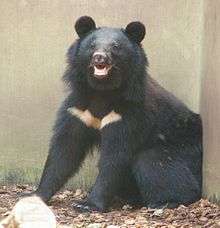Japanese black bear
The Japanese black bear (Ursus thibetanus japonicus) is a subspecies of the Asian black bear that lives on three main islands of Japan: Honshu, Shikoku and Kyushu. There are said to be 10,000 black bears in Japan. The population of black bears on Shikoku and Kyushu may be endangered or extinct. There is a high price on bear parts in the black market, which threatens all bear populations in Japan. This particular species of bear are typically smaller with males only reaching 60–120 kilograms (130–260 lb) and females only weighing about 40–100 kilograms (88–220 lb). Their body length is about 120–140 centimetres (47–55 in) long.
| Japanese bear | |
|---|---|
 | |
| Scientific classification | |
| Kingdom: | Animalia |
| Phylum: | Chordata |
| Class: | Mammalia |
| Order: | Carnivora |
| Family: | Ursidae |
| Genus: | Ursus |
| Species: | |
| Subspecies: | U. t. japonicus |
| Trinomial name | |
| Ursus thibetanus japonicus Schlegel, 1857 | |
| Synonyms | |
|
Selenarctos thibetanus japonicus | |
Diet
These bears are typically herbivorous, eating mainly grasses and herbs during the spring. During the summer, they switch to berries and nuts to feed themselves for their hibernation. The bear is able to get the berries and nuts by climbing trees and using their claws to grab the food. These animals can be omnivorous and eat other wild animals and livestock when there is a need.[1] Like other bears, cannibalism occurs, as has been demonstrated when bone fragments and claws of a cub were found inside the stomach of a male black bear.
Habitat
The bears live on three Japanese islands: Honshu, Shikoku, and Kyushu. They can be found in the northeastern high snow region and the southwestern low snow region; however, they have been spotted as high as the alpine region more than 3,000 metres (9,800 feet) high. They tend to live in areas where there is an abundance of grasses and trees with berries to support their diet.[1]
Seed dispersal
Forests rely on bears as a great method for plants and trees to spread their seeds. The bears will consume the seeds and move 40% further than a distance of 500 m from the parent tree. They have the potential to spread seeds over huge areas, helping the plant life spread throughout the area. In autumn, the bears have a greater seed dispersal rate and usually the males have a larger dispersal areas than females.[2]
Conservation
There has been a huge impact on Japanese black bears' populations due to human interference. Habitat destruction is a problem for these bears as peoples' villages begin to grow. Over-hunting and poaching is also a problem. Bears' parts can be sold on the black market for a high price, which makes them very desirable. People kill a lot of these bears, reducing their numbers drastically. Because of this and the carrying capacity reduction due to habitat destruction has resulted in the recognition that the Japanese black bear is at a high risk of extinction. The species will likely be gone within the next 100 years at the rate they are currently declining.[3]
References
- (Hazumi 1994)
- (Koike, S. 2011)
- (Horino, S. 2000)
Bibliography
- Hazumi, Toshihiro (1994). "Status of Japanese black bear". Bears: Their Biology and Management. 9. International Association for Bear Research and Management. pp. 145–148. doi:10.2307/3872694. JSTOR 3872694.
- Horino, S.; Miura, S. (2000). "Population viability analysis of a Japanese black bear population". Population Ecology. 42 (1): 37–44. doi:10.1007/s101440050007.
- Koike, Shinsuke; Masaki, Takashi; Nemoto, Yui; Kozakai, Chinatsu; Yamazaki, Koji; Kasai, Shinsuke; Nakajima, Ami; Kaji, Koichi (2011). "Estimate of the seed shadow created by the Asiatic black bear Ursus thibetanus and its characteristics as a seed disperser in Japanese cool-temperate forest". Oikos. 120 (2): 280–290. doi:10.1111/j.1600-0706.2010.18626.x.
- Shigeru Azuma; Harumi Torii (February 1977). "A Selection of Papers from the Fourth International Conference on Bear Research and Management". 4. Kalispell, Montana, the USA: 71–79. Cite journal requires
|journal=(help)